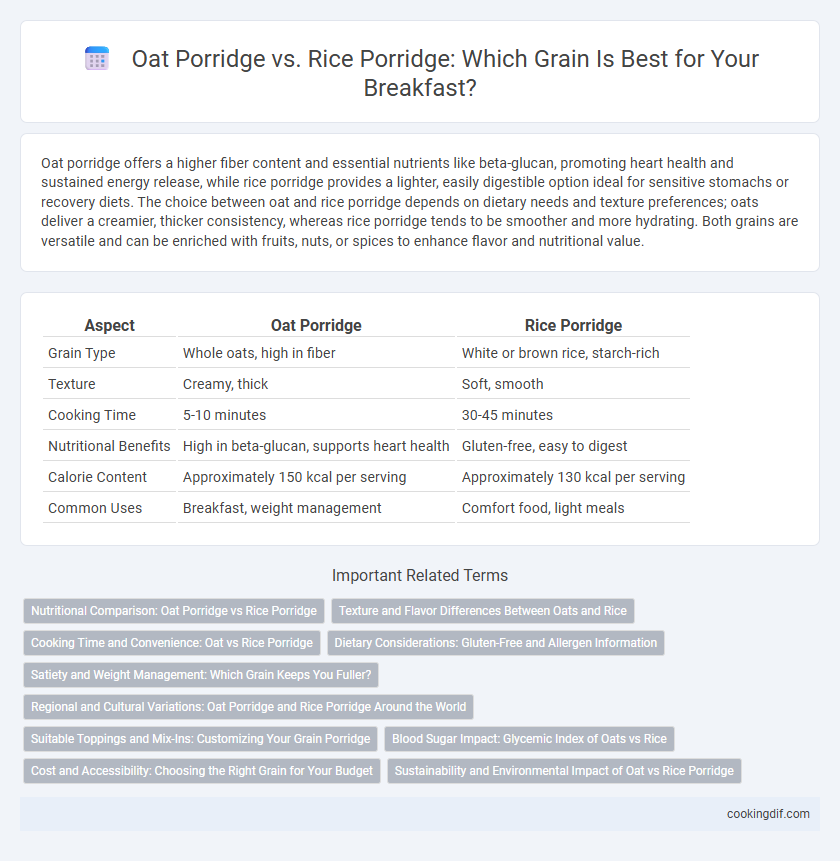Oat porridge offers a higher fiber content and essential nutrients like beta-glucan, promoting heart health and sustained energy release, while rice porridge provides a lighter, easily digestible option ideal for sensitive stomachs or recovery diets. The choice between oat and rice porridge depends on dietary needs and texture preferences; oats deliver a creamier, thicker consistency, whereas rice porridge tends to be smoother and more hydrating. Both grains are versatile and can be enriched with fruits, nuts, or spices to enhance flavor and nutritional value.
Table of Comparison
| Aspect | Oat Porridge | Rice Porridge |
|---|---|---|
| Grain Type | Whole oats, high in fiber | White or brown rice, starch-rich |
| Texture | Creamy, thick | Soft, smooth |
| Cooking Time | 5-10 minutes | 30-45 minutes |
| Nutritional Benefits | High in beta-glucan, supports heart health | Gluten-free, easy to digest |
| Calorie Content | Approximately 150 kcal per serving | Approximately 130 kcal per serving |
| Common Uses | Breakfast, weight management | Comfort food, light meals |
Nutritional Comparison: Oat Porridge vs Rice Porridge
Oat porridge offers a higher fiber content, particularly beta-glucan, which supports heart health and helps regulate blood sugar levels, compared to rice porridge's lower fiber profile. Oats provide more protein and essential micronutrients such as magnesium, phosphorus, and B vitamins, while rice porridge is typically richer in carbohydrates but lacks significant amounts of protein and fiber. The glycemic index of oat porridge is generally lower, making it a better option for sustained energy release and blood sugar management.
Texture and Flavor Differences Between Oats and Rice
Oat porridge offers a creamy and slightly chewy texture with a nutty, robust flavor, while rice porridge features a smoother, silkier consistency and a milder, subtly sweet taste. The higher beta-glucan content in oats lends a thicker mouthfeel compared to the lighter, more delicate texture of rice porridge. Flavor profiles vary as oat porridge provides earthier notes, whereas rice porridge delivers a neutral base ideal for both savory and sweet additions.
Cooking Time and Convenience: Oat vs Rice Porridge
Oat porridge cooks significantly faster, typically taking 5 to 10 minutes compared to rice porridge, which can require 30 to 45 minutes due to the longer grain cooking time. The convenience of quick preparation makes oat porridge ideal for busy mornings, while rice porridge demands more attention and simmering for a smooth, creamy texture. Rice porridge often benefits from soaking or using pre-cooked rice to reduce cooking time, but oats remain the preferred choice for rapid, hassle-free porridge preparation.
Dietary Considerations: Gluten-Free and Allergen Information
Oat porridge offers a nutrient-rich, gluten-free option when certified oats are used, making it suitable for many with gluten sensitivities, while rice porridge is naturally gluten-free and hypoallergenic, ideal for those with gluten intolerance or multiple food allergies. Oats contain avenin, a protein that may cause reactions in some individuals with celiac disease, so certified gluten-free oats are essential for strict gluten avoidance. Rice porridge provides a gentle, easily digestible alternative free from common allergens, supporting sensitive digestive systems and a wide range of dietary needs.
Satiety and Weight Management: Which Grain Keeps You Fuller?
Oat porridge contains higher levels of soluble fiber, particularly beta-glucan, which slows digestion and prolongs feelings of fullness compared to rice porridge. This enhanced satiety helps reduce overall calorie intake, making oats a more effective choice for weight management. Rice porridge, being lower in fiber, tends to be digested faster, resulting in shorter satiety periods and potentially increased hunger.
Regional and Cultural Variations: Oat Porridge and Rice Porridge Around the World
Oat porridge is traditionally favored in Northern European countries such as Scotland and Ireland for its hearty texture and nutritional value, often served with milk or butter. Rice porridge, known as congee in many Asian cultures including China and Thailand, offers a versatile, mild-flavored base commonly consumed during breakfast or as a comfort food. Regional preferences for oat or rice porridge strongly reflect local grain cultivation and cultural culinary practices, influencing preparation methods and typical accompaniments.
Suitable Toppings and Mix-Ins: Customizing Your Grain Porridge
Oat porridge pairs exceptionally well with toppings like fresh berries, nuts, and a drizzle of honey, enhancing its creamy texture and nutty flavor. Rice porridge, often enjoyed as congee, suits savory mix-ins such as sliced scallions, soy sauce, and shredded chicken, offering a comforting, umami-rich profile. Customizing oat or rice porridge with these toppings and mix-ins allows for diverse taste experiences tailored to individual preferences and nutritional needs.
Blood Sugar Impact: Glycemic Index of Oats vs Rice
Oat porridge has a lower glycemic index (GI) compared to rice porridge, resulting in a slower and more gradual increase in blood sugar levels. The soluble fiber beta-glucan in oats helps improve insulin sensitivity and provides sustained energy release, making it a better choice for blood sugar management. Conversely, rice porridge, especially when made from white rice, typically has a higher GI, causing quicker spikes and dips in blood glucose.
Cost and Accessibility: Choosing the Right Grain for Your Budget
Oat porridge offers a cost-effective option with widespread availability in grocery stores and bulk markets, making it accessible for budget-conscious consumers. Rice porridge, while slightly more expensive in some regions, provides a versatile grain choice, especially where rice is a dietary staple and readily affordable. Comparing both, oats tend to yield higher fiber content per serving at a lower price point, ideal for nutritious, economical meals.
Sustainability and Environmental Impact of Oat vs Rice Porridge
Oat porridge has a significantly lower environmental impact compared to rice porridge due to oats requiring less water and producing fewer greenhouse gas emissions during cultivation. Rice paddies contribute to methane emissions, a potent greenhouse gas, and often demand more irrigation, especially in water-scarce regions. Choosing oat porridge over rice porridge supports sustainable agriculture by conserving water resources and reducing carbon footprints associated with grain production.
Oat porridge vs rice porridge for grain choice Infographic

 cookingdif.com
cookingdif.com